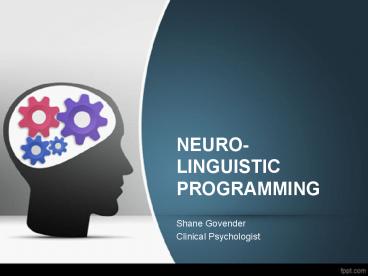NEURO-LINGUISTIC PROGRAMMING - PowerPoint PPT Presentation
1 / 22
Title:
NEURO-LINGUISTIC PROGRAMMING
Description:
NEURO-LINGUISTIC PROGRAMMING Shane Govender Clinical Psychologist WHAT IS NLP? Five Senses Demonstration NLP Further Explained Change interaction with reality. – PowerPoint PPT presentation
Number of Views:1097
Avg rating:3.0/5.0
Title: NEURO-LINGUISTIC PROGRAMMING
1
NEURO-LINGUISTIC PROGRAMMING
- Shane Govender
- Clinical Psychologist
2
WHAT IS NLP?
3
Five Senses
4
Demonstration
5
(No Transcript)
6
(No Transcript)
7
(No Transcript)
8
(No Transcript)
9
NLP Further Explained
- Change interaction with reality.
- Inspiration from psychology and science.
- Curing vs what makes people more effective.
- Change map change behaviour.
- Studying excellence and modelling it.
10
Breaking Down NLP
11
History of NLP
12
Basic Principles of NLP
- Identify patterns in thinking, beliefs and
behaviour choice. - Tools to watch yourself.
- Reality is subjective personal beliefs
perceptions. - Connections between thoughts, perceptions
beliefs. - Eclectic range of theories and disciplines.
- Become conscious of how we are stuck.
- Individuals decide for themselves what their
problems are.
13
The Map is not the Territory
- Habits built on thoughts and behaviour, by
linking new events to old ones (those that appear
similar). Then react in same way. - Trouble dissociating the link between that
stimulus automatic reaction. - NLP helps to become conscious of that link then
reprogram your reactions to something more
appropriate. - The map is not the territory - confusing a
representation, abstraction or reaction to a
thing, with the thing itself. E.g., Restaurant
menu.
14
(No Transcript)
15
NLP in Life
- Happy in 1 / gt parts of life gt possibility of
spill over. - Isolating Quantifying traits communication.
- Modelling.
- Verbal non-verbal communication.
- 5 senses main avenues of receiving information.
- Catalogue each new experience, 1st attempting to
match it to a previous one. Storing it as
something new (to us anyway). - This becomes our version of reality.
- Recall this information using one of the 5 senses
e.g., we can see it in pictures, feel it
kinaesthetically, or hear it as sounds. - Kinaesthetic Im out of step Visual I
dont see what you mean Auditory It doesnt
sound good to me.
16
Example
17
Know what you want!
- Vagueness Universe If you dont know....
- Success sticking to goals.
- Realistic expectations.
- With a strong enough reason, the motivation to
act will follow naturally. - Goals challenging, above comfort zone but
realistic.
18
Anchoring
- Associating a memory or feeling to something
else. - Example memory as a child (happy). Feelings are
anchored to that memory. - Becoming aware consciously decide which anchors
to keep which ones to remove or modify. - Novelists Filmmakers.
19
(No Transcript)
20
NLP in Therapy
- Two main therapeutic uses (a) used as an adjunct
by therapists practising in other therapeutic
disciplines (b) as a specific therapy called
Neuro-linguistic Psychotherapy (recognised by UK
Council of Psychotherapy NL P and Council
Association).
21
Practical Steps in Therapy
- Build rapport (established through pacing and
leading the verbal non-verbal behaviour
matching mirroring non-verbal behaviour /
responding to eye movements of client). - Gather information about clients present state
and help client define a desired state or goal. - The client is typically encouraged to consider
the consequences of the desired outcome. - Make interventions in clients life using tools
techniques to change internal representations
responses to stimuli in the world. - Some tools include indirect suggestion from the
Milton model, and reframing. It also involves
discourse analysis practical guidelines for
improved communication.
22
(No Transcript)































